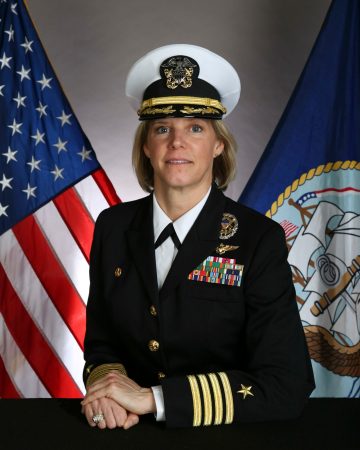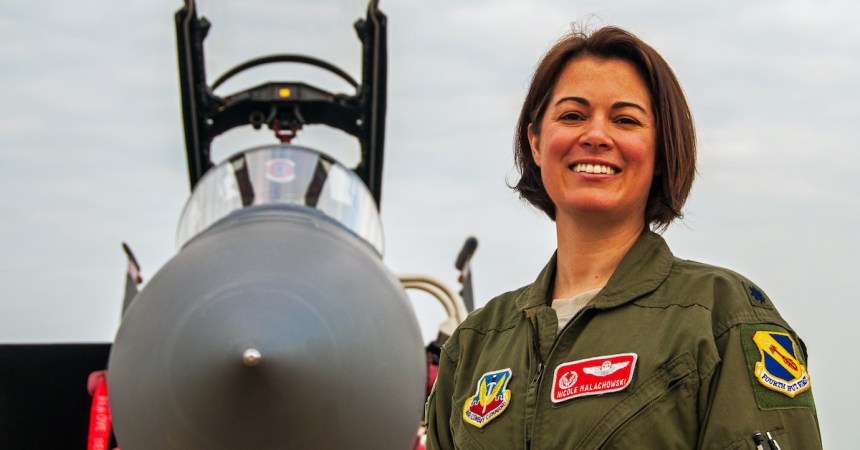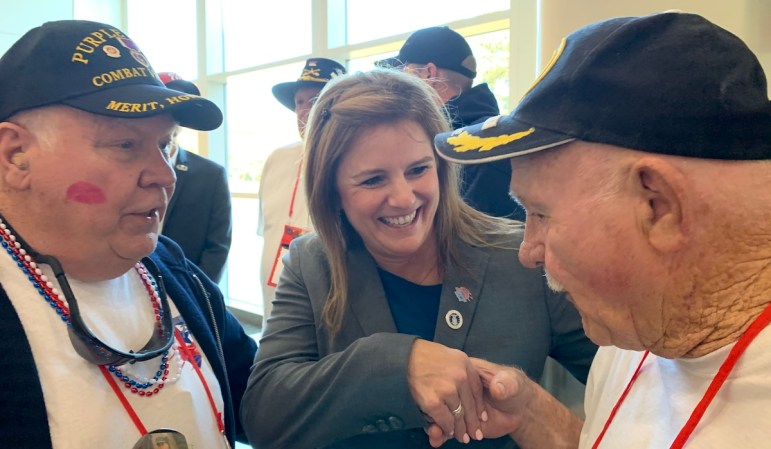
The F-14A Tomcat was a hard airplane to land aboard an aircraft carrier. Engine response was slow. A wingtip-to-wingtip distance of nearly 70 feet meant there wasn’t much room to deviate away from the centerline of the landing area on the flight deck. Any lateral stick input caused the airplane to yaw in the opposite direction, which forced the pilot to simultaneously feed in rudder to counter. The velocity vector on the heads-up display wasn’t accurate enough to be used as a flight path marker. The tail hook-to-eye distance was more than any other airplane in the wing, which made any vertical corrections very precarious in the endgame.
And for her crime of doing well in flight school, then-Ensign Carey Lohrenz was selected to fly Tomcats, the first female naval aviator to get orders to that community. And by accepting those orders, Lohrenz embarked on a pioneer’s journey, one that had more ups and downs than anyone could have predicted, and one that would have crushed the spirit of the average American woman.
But Carey Lohrenz isn’t an average American woman.
Lohrenz developed a love of sports while growing up in Green Bay, Wisconsin. While she claims she wasn’t a tomboy, she played little league hockey on boy’s teams until high school. (“I quit when they started taking a little too long to get off of me after a check,” she jokes.) After that she took advantage of her six-foot-tall stature and joined the volleyball and basketball teams.
At the same time another love was growing inside of her: aviation. Her father was an airline pilot who’d flown C-130s in the Marine Corps, and her mother was a flight attendant. Both she and her older brother were determined to fly, and they often discussed the best routes to make a career out of flying.
But Lohrenz didn’t discuss her dream with anyone else. “I didn’t want their doubts about what females could do at that time to taint my dream,” she said.
So as soon as she had her Psychology degree from the University of Wisconsin in hand, she followed her brother’s lead and applied for the Navy’s Aviation Officer Candidate School. Months later she reported to Pensacola, Florida for flight training.
Her brother was just over a year ahead of her in the training pipeline, and in spite of the fact he selected the transport community (and ultimately wound up flying E-6s) she wanted to fly tactical jets. And because her performance was at the top of her class, she got what she wanted.
But her selection for jet training came with some inherent tension. The combat exclusion law that prevented females from being assigned to carrier-based squadrons was still very much in place in the early 1990s. The only jets that females were piloting were shore-based EA-6s that flew missile profiles against surface ships for training.
“I got a lot of ‘why are you here?’ questions from instructors and fellow flight students,” Lohrenz said.
But she was undeterred and pressed on with an eye on what she hoped might happen. “If combat billets opened up I wanted to be in a position so that nobody could say I got a slot simply because I was a girl but because I was qualified,” she said.
But in spite of her hope and planning, it wasn’t looking good as she neared the end of her flight training.
“I got a call six weeks before I was supposed to get my wings that the combat exclusion clause hadn’t been lifted and there was no place for me to go,” Lohrenz said. “I could get out of the Navy or go to a non-flying job.”
She hung up the phone and went back to her scheduled flight brief and fought the instinct to cry.
The next day she went to her commanding officer and asked him to find “a third way.”
“I wasn’t taking no for an answer,” she said. And because she’d done well her CO went to bat for her.
But he didn’t have to try too hard because about that same time the combat exclusion law went away. Lohrenz pinned on her Naval Aviator’s Wings of Gold and got orders to VF-124, the F-14 training squadron at NAS (now MCAS) Miramar in southern California, the first female to go right from winging to Tomcats. (The other females were transferred from the EA-6 community.)
But the challenges for Lohrenz didn’t end there.
“I got to Miramar as the trifecta of bad things were happening,” she said.
There was the fallout from the Tailhook scandal that resulted in careers ending for several high-ranking and popular fighter crews. There was a Navy-wide reduction in force happening that was forcing people out of the service against their will. And there was disappointment in the Tomcat community about the fact that the F-14 wasn’t getting upgraded.
One of the instructors posted two articles on the main bulletin board in the ready room: One about how the upgraded F-14 was being cancelled, and one that highlighted that the cost to retrograde ships for females was $200 million.
“There was a lot of animosity that had nothing to do with me but merely my presence,” Lohrenz said. “It wasn’t an easy environment. It took an unwavering belief that I had the ability to do the job.”
She had the first hiccup in her flight training toward the end of the VF-124 syllabus, failing to qualify the first time she tried landing the Tomcat on the carrier. But she wasn’t alone. About 75 percent of her class failed the first time, primarily due to the weather conditions that resulted in rough seas that made an already difficult task of landing a beast of an airplane on the ship for the first time even harder.
Lohrenz focused on her additional training and qualified without any issues the second time through.
She joined her first fleet squadron – VF-213 “Blacklions” – at the most rigorous phase of pre-deployment training, one of two female pilots in the squadron.
The other female pilot was Lt. Kara Hultgreen. Hultgreen was senior to Lohrenz and had come to the Blacklions by way of the EA-6 community.
“Because she had a lot of flight hours people assumed she was experienced,” Lohrenz said.
Two months into Lohrenz’ tour tragedy struck. Hultgreen’s Tomcat had an engine stall in the landing pattern behind the carrier, and she lost control and crashed. While the backseater managed to initiate ejection in time to save his own life, Hultgreen was killed.
The mishap became a lightning rod of emotions and political agendas. Experienced pilots believed Hultgreen had mishandled a basic inflight emergency and that her death was her own fault. Others resented the level of effort that was put into recovering the Tomcat from the bottom of the ocean.
“Nobody addressed the details of the situation and it caused a lot of people to feel less valuable and hurt morale,” Lohrenz said. “And there was a bit of a leadership vacuum that could have nipped the whole thing in the bud.”
Lohrenz was now the sole female carrier-based fighter pilot.
“If I thought the spotlight was bad before it was now nuclear fusion level,” she said.
She was caught in a lose-lose matrix of sorts. “If I was stoic people thought I didn’t care,” she explained. “And if I showed emotion people thought I was a bitch.”
The atmosphere on the carrier was increasingly uncomfortable, even insulting, as the deployment wore on. Female crew were made to take pregnancy tests after every in-port period. The admiral in charge stated in a very public forum that the reason he supported women aboard ships was “because they made the carrier smell better.”
She tried to simply do her job, to fly the airplane and perform as a normal first-tour junior officer should, but that ultimately wasn’t enough to overcome the forces around her.
“To be cryptic about it, the rug was yanked out from under me by a cadre of people who didn’t want women in the military . . . period,” Lohrenz said.
She saw a shift in her commanding officer’s attitude. Her previous landing grade performance that had characterized her as a normal first tour pilot dealing with an airplane that was just plain hard to control now had her listed as “unsafe and unpredictable.”
“I was set up,” she said.

Lohrenz was given an evaluation board that pulled her out of the Tomcat community and assigned her to fly small propeller-driven transports from a shore base. She left the Navy shortly after that.
But in spite of the challenges and the emotional turmoil, Lohrenz has used the experience as a pivot point. “I went from Mach 2 to mom to entrepreneur,” she said.
During the course of being a homemaker, which included being a wife to a FEDEX pilot and raising four kids, she found herself increasingly being sought after for business advice, especially that pertaining to organizational change.
Lohrenz connected the dots and – after a short and semi-chaotic stint with a consulting firm run by military aviation alums – she launched Carey Lohrenz Enterprises. She is now in high demand as a consultant and keynote speaker.
Her efforts are anchored by her book Fearless Leadership that outlines her approaches to both business and life. The book is organized around the three fundamentals of “real fearlessness” — courage, tenacity, and integrity — and offers Lohrenz’ take on how to stay resilient through hard times.
And Lohrenz’ life would suggest that staying resilient is something about which she knows a thing or two.










